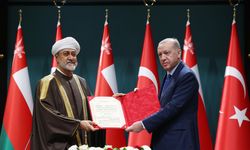The UK, Italy, and Japan, partner countries in the Global Combat Air Programme (GCAP), have introduced a new prototype of their upcoming generation of fighter jets at the Farnborough International Airshow, taking place in the UK from July 22 to 26.
Making their joint debut at the show, the three government partners of GCAP and their main industry counterparts, BAE Systems of UK, Leonardo of Italy and and Mitsubishi Heavy Industries (MHI) of Japan are set to highlight substantial advancements in developing the aircraft.
The new concept model boasts a significantly refined design with a larger wingspan compared to earlier concepts, aimed at enhancing the aerodynamics of the future combat aircraft.
Herman Claesen, Managing Director of the Future Combat Air Systems division of BAE Systems said since the launch of the GCAP 18 month ago, they have been “working closely with our industrial partners in Italy and Japan under the collaboration agreement, and also with the three governments, to understand and align requirements for a next generation combat aircraft.”
“The new model, unveiled at Farnborough International Airshow, shows notable progress in the design and concepting of this future fighter jet. We’ll continue to test and evolve the design, as we move closer towards the next phase of the program,” he said.
Guglielmo Maviglia, Chief Global Combat Air Program Officer at Leonardo, meanwhile, said the pace of the program “is extraordinary, building on a solid foundation and industrial legacy in each country and government-led partnership.”
“Since the treaty was signed in December 2023, the program has seen strong commitment from each partner. Each brings different, but complementary, qualities and requirements. We are now working closely together to exchange knowledge, address common challenges and achieve common goals. The program is immensely important for Italy, for Leonardo, including our UK-based business, and for wider Italian industry. GCAP represents the future of combat air in a System of Systems perspective for our generations to come,” Maviglia said.
“MHI considers any project to be a valuable opportunity to deepen our knowledge. In particular, since GCAP is a three-country joint development program between Japan, UK and Italy, we expect to obtain better results and deeper knowledge than ever before by combining the different cultures, experiences and knowledge of the three industries involved,” MHI’s Hitoshi Shiraishi who is a senior fellow at GCAP said.
“I also hope that this GCAP program, with the broad participation of Japan’s defense companies, will foster innovation in the country’s industrial sector such as digital transformation, as well as the development of human resources in the field of science and technology,” Shiraishi said.
Scheduled for deployment by 2035, the combat aircraft will rank among the globe’s most advanced, interoperable, adaptable, and interconnected fighter jets.
It will feature an intelligent weapons system, a software-driven interactive cockpit, integrated sensors, and a high-powered next-generation radar capable of processing 10,000 times more data than existing systems, providing a decisive edge in battle.
GCAP stands as a crucial strategic partnership uniting the governments of the UK, Italy, and Japan with their respective industries. Together, they collaborate on shared military and industrial goals to deliver a next-generation combat air capability.
The GCAP holds immense importance for the security, political stability, and economic prosperity of each participating nation. Through effective knowledge and technology transfer, it aims to enhance and maintain crucial sovereign combat air capabilities across the UK, Italy, and Japan for generations to come.
The program is expected to create employment opportunities for tens of thousands of skilled individuals across these nations, fostering the growth of industrial skills and advancing technologies essential for the future.










